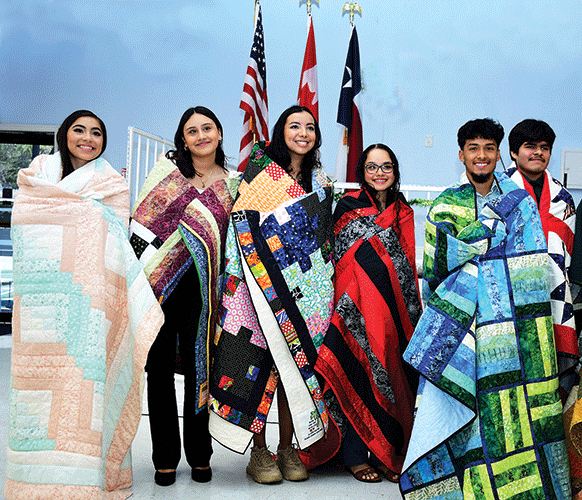 Alamo Palms’ Scholarship Committee donates $22,000
Alamo Palms’ Scholarship Committee donates $22,000
By Barb Zanetti
Photos by Dennis Zanetti
While modeling his beige Union Suit and wide-brimmed, felt, brown hat, Rip Van Winkle (Brad Mallow) seemed to awaken. He paused. Turned. And then scooted back down the runway to steal an unexpected kiss from Miss Havisham (Beverly Bailey), who was gripping her wilted bouquet.
Surprised laughter erupted from the audience at this year’s Alamo Palms’ Ropa Style Show held recently.
Rip Van Winkle and Miss Havisham joined 28 other runway models featured in the “What a NOVEL idea” theme. The show was one of the park’s fundraising events held to benefit Alamo High School seniors.
This year 22 PSJA Memorial Early College High School [ECHS] seniors were each awarded a $1,000 scholarship from the Alamo Palms Scholarship Fund.
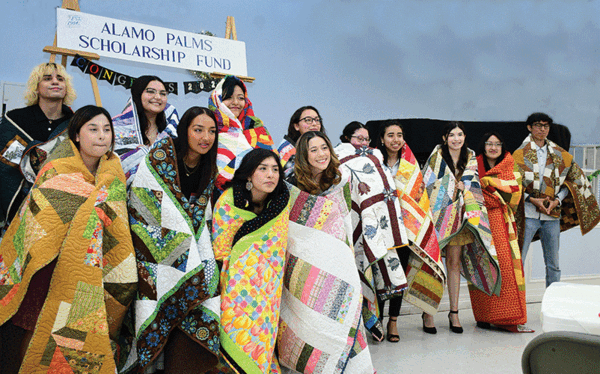 “This fundraising is something that residents feel passionate about,” Nancy Nielsen, Scholarship Committee co-chairperson, said. “That’s unique among retirees, especially since this isn’t their home. This isn’t where they grew up. But they embrace this fundraising effort. I think that sets them apart from other parks.”
“This fundraising is something that residents feel passionate about,” Nancy Nielsen, Scholarship Committee co-chairperson, said. “That’s unique among retirees, especially since this isn’t their home. This isn’t where they grew up. But they embrace this fundraising effort. I think that sets them apart from other parks.”
Despite the extraordinary amount of money raised each year by the park’s Winter Texan residents, they say they enjoy themselves in the process, according to Nielsen.
“We come down here to have fun and to cater to ourselves,” she said. “Most of us retirees, … we’ve already done our [work] thing. We have a hell of a good time, but we dig deep in our pockets, too.”
To make the money-generating events a success, Diane Mork, Ropa style show organizer, said a lot of credit has to go to the residents.
“People are so good here,” she said. “They’re outgoing. They volunteer. They do all the things that make things run well …. And that makes it fun.”
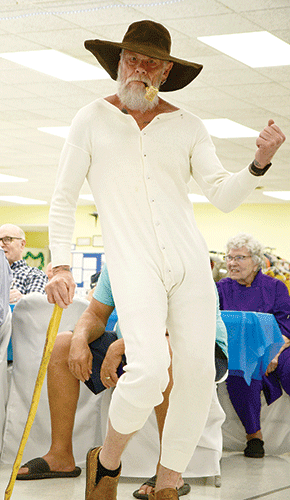 Along with making generous donations, park residents devote much time to organizing and working for the money-generating events that fund the scholarships.
Along with making generous donations, park residents devote much time to organizing and working for the money-generating events that fund the scholarships.
Event Planning on Steroids
To be honest, Mork admitted she devoted an enormous amount of time to the Ropa style show.
“I don’t have to work-work at it,” she said. “I spend time, a lot of time, but I don’t consider it work. It’s time well spent.”
Her show’s “non-work” organizing began when she chose this year’s novel theme. Her idea was to introduce 60 different novels, so that her 30 models would walk the runway twice.
She said her next challenge was to research the most popular novels dating back to the 1940s.
After that she checked to see if several Ropa Usada’s* [Spanish for “used clothes”] were still in business, so she could create a shopping map for her volunteer models.
Then, she led shopping trips to the clothing warehouses, where bales of clothing were opened and moved with a skid loader to form enormous piles. Her models were tasked with selecting clothes they thought might work for them by either walking around the outskirts of the piles or climbing up on the mounds.
Mork said she participated too.
She chose to go high. Climbed. Sat down. And then started pulling things out to look at them. If the item didn’t work, she tossed it over her shoulder and pulled out another until her pillowcase bag was filled. Then, like the volunteer models, she paid for the clothing by the pound.
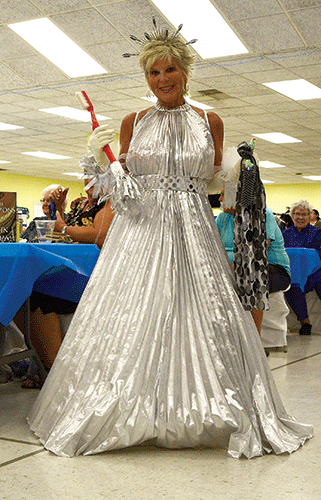 From there the models brought their “finds” to her Texas room “boutique,” where they chose the outfits they wanted to model. The next step was for models to match their chosen outfits to specific novel characters.
From there the models brought their “finds” to her Texas room “boutique,” where they chose the outfits they wanted to model. The next step was for models to match their chosen outfits to specific novel characters.
The models completed forms for every character. These preprinted sheets asked for descriptions of the costumes they planned to wear, including such details as style, color, manufacturer, and condition of the clothing. Most of this information was incorporated into Mork’s runway narration.
After receiving the models’ forms, Mork read summaries of all the novels that would be featured in the style show. She said this helped her to write her show’s script, which took her approximately five days to complete.
Although Mork was there to consult and guide the models, they did have plenty of creative control.
“The models decide for themselves what they’re going to do to make it fun for them,” she said, adding that they each find their own props. “They say they don’t want to be just a model; they want to BE the novel’s character.”
Mork said she enjoyed and was proud of all the “novel” models, while she did admit to having a few favorites in this year’s show.
“I was an elementary teacher, so I’m really partial to kids’ books,” she said while deciding which novel character she liked best. “I really loved Pippi Longstocking (Sue Olson). … Her spunkiness and her outlook on life are just fun.”
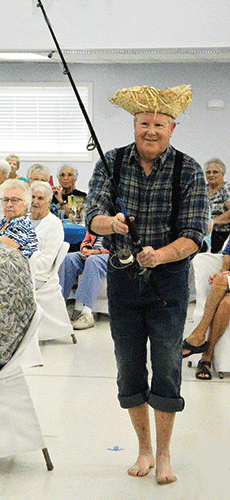 On the runway, Pippi carried Mr. Nillson, her multi-talented monkey friend, featured in Astrid Lindgren‘s novel.
On the runway, Pippi carried Mr. Nillson, her multi-talented monkey friend, featured in Astrid Lindgren‘s novel.
In addition to the modeling, Mork said she loved the Shel Silverstein poems that were enacted in brief skits interspersed throughout the afternoon.
A Unique Auction
Along with the Ropa Style Show, the Scholarship Committee sponsored another major event to help bolster the park’s scholarship fund -- its annual auction.
What’s unusual about the auction is that residents donate all the items and then often pay exorbitant prices to buy them back. Nothing is solicited from area merchants or other sources.
Park newcomers said they were amazed when a non-descript purplish necktie sold for $900. They learned from the auctioneer that the same tie has been returned and re-auctioned every season for at least the last 10 years.
Another staple of the auction in recent years was a pair of suspendered underwear that provided giggle material for the audience. The apparel, too, went for a large sum, and will, no doubt, be on the auction block again next year.
(These two clothing items are exceptions to the auction’s guidelines because clothes and shoes are excluded from the list of items that can be donated.)
This year’s resident-donated items included large bundles of giant zip ties, a spray-on make-up kit, an antique table, giant crossed holiday candy canes that light up, an air conditioner, a wine fridge, a guitar, a rowing machine, matted and framed pencil drawings, an oil painting, an RC car, RC drones and so much more.
Despite the variety of auction items, baked goods have been its biggest money maker. For example, this year a lemon meringue pie sold for $200, while bread pudding sold for $100.
Mork said she paid $70 for a quart-sized bag of homemade caramel corn.
“It’s worth it to me,” she said. “And knowing it’s going to a good cause makes it easy.”
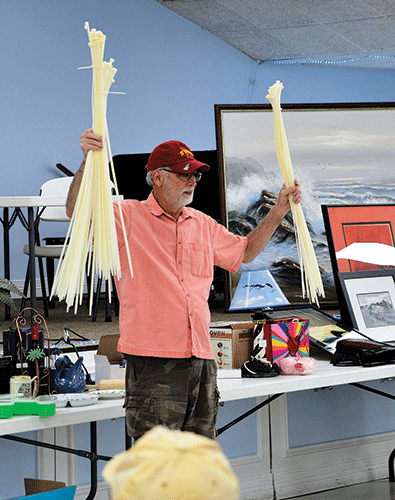 Scholarships for Local Students
Scholarships for Local Students
PSJA Memorial ECHS Financial Aid Officer Erica Denae Ramos said students value the residents’ efforts, especially after she explains the park’s generosity to her students.
“Not only do the Alamo Palms Winter Texans fundraise all year just for these scholarships,” she said, “but some residents have given substantial memorial donations to this fund.”
After hearing this, she said, the students have an “Ah ha!” moment like “I didn’t know that! Wow! This is that much money that’s available?”
“It’s an awesome surprise for them when they realize the total amount of the residents’ amazing generosity,” the educator said, “… and then where the money comes from.”
This year 56 of 450 Memorial High School seniors applied for the scholarships.
The seven-member Scholarship Committee works with Ramos to review all applicants’ portfolios, which include such items as their high school transcript, college entrance scores, a resume, an essay and community service activity, as well as their accomplishments and goals.
“The scholarship opportunity shows our students that the Alamo Palms community cares about them … that Winter Texans care,” Ramos said. “Granted, Winter Texans will hunt down a deal… a $1 or $2 burger – and they’ll travel for it. At the same time, they’re unbelievably generous. And unbelievably kind. And that is the reputation that precedes Alamo Palms’ residents.”
On March 10, the Scholarship Committee invited all 22 scholarship recipients and their parents to a reception. There students spoke about their goals and how the scholarships will impact their futures.
A highlight of this ceremony was when the Quilt Committee (co-chaired by Cindy Biggerstaff and Beverly Bailey) surprised the 22 selected students with quilts matched to their personalities (based on their student essays). Each of the 22 quilts is valued at a minimum of $300 for material and cost of quilting, not including labor. Some quilts take up to a month to complete.
The reason the Quilt Committee donates their creations, according to Ramos, is that “they want to make sure those students going away to college will take a bit of ‘home’ with them… something hand made with love.”
“It’s a beautiful surprise,” Ramos said. “I’ve often heard the kids say, ‘Honestly, the quilt alone was worth being selected.’ They’ve loved their quilts, which have been unbelievably popular.”
Park Benefits
The many different groups of residents pulling together and contributing to the scholarship effort has impressed Delaila Zarate, Alamo Palms Park Manager.
“More than anything I love the unity it brings to the park and to the residents,” she said. “I think the excitement that the scholarship effort generates spreads from the Alamo Palms Park community to benefit the greater Alamo community, all the while contributing to students’ needs.”
She said she’s proud of her residents’ efforts because so much goes into every event.
“It seems that there are no boundaries to what our residents can and will do,” Zarate said. “Something tells me they’re going to get even more creative. They’re great!”
*(Mork said that it’s important to those working on the Ropa show that everyone knows this event does not belittle or demean the Ropa reseller of overstocked and gently used clothing. Many local people buy and resell its clothing, which supplements part of their income. This makes Ropa warehouses a valuable benefit to the community.)
(HISTORICAL NOTE: The Alamo Palms Scholarship Fund was created in 1982 as a result of the new Texas Bingo law that required parks to donate 10% of their profits to a charity of their choice. The first scholarship Alamo Palms awarded to a Memorial High School senior totaled $250. Soon, the fund grew so that one senior boy and one senior girl were recipients. Meanwhile, fundraising was added to the park’s bingo profits. Those scholarships eventually topped out at $1,000 apiece. Depending on the amount the Scholarship Committee raises each year, the number of scholarships awarded varies.)













